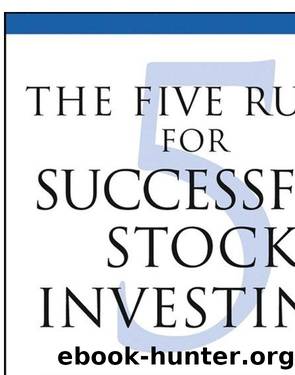The Five Rules for Successful Stock Investing: Morningstar's Guide to Building Wealth and Winning in the Market by Pat Dorsey

Author:Pat Dorsey [Dorsey, Pat]
Language: eng
Format: epub
Tags: Non-Fiction, Business & Money, Investing
ISBN: 978-1-118-04562-6
Publisher: Wiley
Published: 2011-01-03T16:00:00+00:00
Beyond the 10 Minutes
If the firm does pass these tests and it looks as though itâs worth a detailed examination, hereâs how to proceed. This research process will take much longer than 10 minutes, but itâs worth the effort for an idea that passes the initial hurdles:⢠Look over the 10-year summary balance sheet, income statement, and statement of cash flows on Morningstar.com or another Web site. Look for trends, and make notes of anything that raises an eyebrow and deserves further investigation. This process should give you an initial road map for investigation.
⢠Read the most recent 10-K filing front to back. Pay special attention to the sections that describe the company and its industry, the sections about risks and competition, any mention of legal issues (sometimes labeled âcommitments and contingenciesâ), and the âmanagementâs discussion and analysisâ section. The latter is where the firm explains, in reasonably plain English, why the most recent yearâs financial results were what they were. Write down anything you donât understand or which you want to investigate further. You donât necessarily need to read every page of the 10-Kâsometimes firms include scores of pages of mind-numbing detail about leases, for exampleâbut you should at least skim every page to make sure thereâs nothing buried in the text that you do need to know. Be on the watch for any sections that describe loans, guarantees, contractual obligations, or the like. If the firm is going to owe someone a large amount of money in a few years, you need to know about it.
⢠Read the two most recent proxies (form DEF-14A, in the SECâs jargon). Look for reasonable compensation that varies with corporate financial performance and a reasonable options-granting policy. Check to make sure the board of directors isnât packed with individuals with close ties to management.
⢠Read the most recent annual report, as well as the past two yearsâ reports, if possible, to get a feel for the company. Is the letter to shareholders candid and frank, or does management gloss over problems with jargon? Ignoring problems wonât make them go away, after all. In addition, does the firm present industry information to give you context for evaluating it? Does the report look as though the firm spent way too much money on it?
⢠Look at the two most recent quarterly earnings reports and 10-Q filings to see whether anything has changed recently. Look for signs that business is getting betterâor worseâas well as for anything major that has changed since the last 10-K. If itâs still available, listen to the most recent quarterly conference call. (Companies often archive these on their Web sites for some time after the quarter is over.) Does management get defensive or evasive when analysts ask tough questions, or does it respond with straightforward answers?
⢠Start valuing the stock. Look at the stockâs valuation multiples relative to the market, the industry, and the stockâs historical valuation ranges. If the firm has low reinvestment needs, low risk, high returns on capital, or a high growth rate, be prepared to accept a higher price-to-earnings ratio.
Download
This site does not store any files on its server. We only index and link to content provided by other sites. Please contact the content providers to delete copyright contents if any and email us, we'll remove relevant links or contents immediately.
Rich Dad Poor Dad by Robert T. Kiyosaki(6185)
Pioneering Portfolio Management by David F. Swensen(6083)
How To Win Friends and Influence People by Dale Carnegie(4339)
The Money Culture by Michael Lewis(3850)
The Dhandho Investor by Mohnish Pabrai(3562)
The Wisdom of Finance by Mihir Desai(3528)
Liar's Poker by Michael Lewis(3228)
The Intelligent Investor by Benjamin Graham Jason Zweig(2932)
The ONE Thing by Gary Keller(2920)
Mastering Bitcoin: Programming the Open Blockchain by Andreas M. Antonopoulos(2894)
Fooled by Randomness: The Hidden Role of Chance in Life and in the Markets by Nassim Nicholas Taleb(2862)
Rich Dad Poor Dad: What The Rich Teach Their Kids About Money - That The Poor And Middle Class Do Not! by Robert T. Kiyosaki(2836)
Investing For Dummies by Eric Tyson(2797)
How to Win Friends and Influence People by Dale Carnegie(2796)
How to Day Trade for a Living: Tools, Tactics, Money Management, Discipline and Trading Psychology by Andrew Aziz(2786)
Market Wizards by Jack D. Schwager(2543)
Zero Hour by Harry S. Dent Jr. & Andrew Pancholi(2536)
How to Pay Zero Taxes, 2018 by Jeff A. Schnepper(2503)
Rich Dad's Guide to Investing by Robert T. Kiyosaki(2412)
